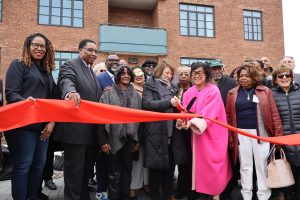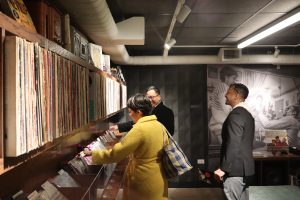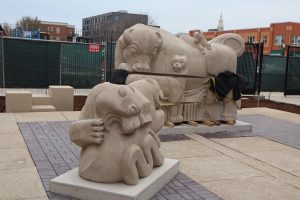National Public Housing Museum aims to transcend stereotypes, encourage reform
By Igor Studenkov for Chronicle Media — April 29, 2025
The National Public Housing Museum is located inside a renovated Jane Addams Homes public housing building. (Photo by Igor Studenkov/for Chronicle Media)
It took almost three decades, but the National Public Housing Museum officially opened to the public on April 4.
Located in the only surviving building from the Jane Addams Homes public housing development in Chicago’s Little Italy neighborhood, at 919 S. Ada St. The museum was born out of the advocacy of public housing tenants who were worried that, amid the Plan for Transformation, which sought to replace public housing high-rises with slightly shorter mixed-income buildings, their stories would get lost.
From the get-go, the goal was to show that life in places like Jane Addams Homes was more than poverty, crime and deteriorating living conditions. As the speakers emphasized during the April 4 ribbon-cutting, it was a place where people raised their families, artists found inspirations, enduring friendships were forged, and tenants came together to lobby for better conditions. And, since access to housing remains an issue, the museum is also meant to encourage advocacy.

National Public Housing Museum officials and city officials prepare to cut the ribbon for the National Public Housing Museum. (Photo by Igor Studenkov/for Chronicle Media)
The theme of displacement came up in several speeches. While high-rises in development like Cabrini Green and Robert Taylor Homes were torn down, two decades later, the mixed-income housing that was supposed replace it only partially materialized. While the tenants who lived in the high-rises were given a right to return to the public housing units in the new buildings, many are still waiting.
The museum building does include 15 housing units on the Taylor Street side, which are accessed through a separate entrance.
Jane Addams Homes was the first in what became a cluster of four public housing developments known as ABLA Homes (after Jane Addams Homes, Robert Brooks Homes, Loomis Courts and Grace Abbott Homes). Under the Plan for Transformation, only Loomis Courts were rehabbed. Some Brooks Homes rowhouses were torn down, Abbott Homes high-rises were torn down completely, and so were 31 out of 32 buildings that made up Addams Homes.
The Roosevelt Square mixed-income development that was supposed to replace it was only partially competed. The mixed-income building that includes a public library on the first floor was built right next to the public housing museum. The former site of Abbott Homes was controversially turned over to Chicago Fire soccer team for their new practice field.

Visitors look at records at the REC Room, an exhibit featuring works of artists who lived in public housing. (Photo by Igor Studenkov/for Chronicle Media)
In mid-1990s, Deverra Beverly, then a member of the ABLA Homes Community Adivsory Council, approached philanthropist and former public housing resident Sunny Fischer about starting a public housing museum. Since then, the plans went through several changes as more people joined the effort and organizers tried to first make sure the building wasn’t torn down, then raised $16.5 million through a combination of donations, private, state and city grants to rehab and renovate the building. The city contributed $4.5 million through federal stimulus-funded Chicago Recovery Plan grant and $1 million in Tax Increment Financing revenue.
The museum includes re-creations of three apartments that represent three different eras of Chicago public housing, a recording studio that collects oral histories of public housing residents and several art and exhibition spaces. This currently includes the REC Room, an interactive exhibit featuring music that has its roots in public housing, an exhibit featuring recordings of the residents of the Cabrini-Green public housing development sharing their impressions of the Good Times TV show, and Still Here, and exhibit chronicling displacement in Little Italy going back to the Native American tribes that inhabited the area before Western colonization.
In a unique touch, everything on sale at the museum store comes from businesses owned by public housing residents.
Bob Fioretti was the alderman of the 2nd Ward in 2007 through 2015, when it included ABLA Homes site. He was among the guests at the grand opening.

The animal sculptures that used to dot Jane Addams Homes courtyard have been cleaned up and included in the museum. (Photo by Igor Studenkov/for Chronicle Media)
“I had to fight to save the building, and we’re about to have hundreds of visitors,” Fioretti reflected. “It’s just a monument to the people who understand the value of public housing and what public housing can do for everyone.”
The Rev. Marshall Hatch Sr., an influential Chicago West Side faith leader, grew up at the very Jane Addams building that became the public housing museum. His family apartment was re-created as an example of the 1960s era. During the grand opening, he reflected that the grand opening happened to fall on the 57th anniversary of Dr. Martin Luther King Jr.’s assassination. Hatch noted that the civil rights leader came to Chicago to combat housing segregation on the West Side.
“So, we remember Martin and Coretta (Scott King) as our neighbors,” he said, adding that it was important to remember “the communities that were displaced, but never erased.”
Fischer, who currently chairs NPHM’s board of directors, recalled that, when she was visiting the building almost two decades ago, Hatch happened to be driving by, and he ended up telling her about his experiences. She saw the encounter as a sign that that the museum founders were on the right path.
“This museum was built by hundreds of dedicated people who have made it a reality,” she added. “They shared their stories, and they patiently provided their labor and love and support over the last 18 years.”
Fischer reflected that Jane Addams Homes were “built by the government that believed that housing is a human right.”
“That’s the spirit that needs to return,” she said.
Mayor Brandon Johnson said that the city is currently building 1,800 affordable units and 4,600 are anticipated in the next 18 months. He alluded to the second President Donald Trump administration’s new policies when describing the museum’s importance.
“When oppressive regimes come in, they try to erase our history, our culture,” Johnson said
Angela Hurlock, Interim CEO of the Chicago Housing Authority praise the “commitment, determination, resourcefulness, but most importantly passion” of the people behind the museum.
“We never dreamed it would take this long, but through a number of administrations, ups and downs and the pandemic, we persevered,” she said.
Lisa Lee, the museum’s current executive director, said that “For the record, I never doubted the museum would open” before quickly adding “maybe occasionally.”
“The dazzling stories, precious keepsakes, compelling cultural production of public housing, and activism of public housing residents have much to teach us,” she said. “And because housing insecurity and injustice is such a critical issue facing so many people across our nation, the National Public Housing Museum will be an important civic anchor that brings people together to imagine innovative solutions and envision a more equitable future.”
National Public Housing Museum is open from 10 a.m.-5 p.m Wednesday and Friday through Sunday and 10 a.m.-8 p.m. Thursday. For more information, visit https://nphm.org/







